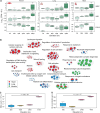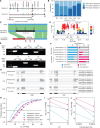Multi-omic Analyses Shed Light on The Genetic Control of High-altitude Adaptation in Sheep
- PMID: 39142817
- PMCID: PMC12016566
- DOI: 10.1093/gpbjnl/qzae030
Multi-omic Analyses Shed Light on The Genetic Control of High-altitude Adaptation in Sheep
Abstract
Sheep were domesticated in the Fertile Crescent and then spread globally, where they have been encountering various environmental conditions. The Tibetan sheep has adapted to high altitudes on the Qinghai-Tibet Plateau over the past 3000 years. To explore genomic variants associated with high-altitude adaptation in Tibetan sheep, we analyzed Illumina short-reads of 994 whole genomes representing ∼ 60 sheep breeds/populations at varied altitudes, PacBio High fidelity (HiFi) reads of 13 breeds, and 96 transcriptomes from 12 sheep organs. Association testing between the inhabited altitudes and 34,298,967 variants was conducted to investigate the genetic architecture of altitude adaptation. Highly accurate HiFi reads were used to complement the current ovine reference assembly at the most significantly associated β-globin locus and to validate the presence of two haplotypes A and B among 13 sheep breeds. The haplotype A carried two homologous gene clusters: (1) HBE1, HBE2, HBB-like, and HBBC, and (2) HBE1-like, HBE2-like, HBB-like, and HBB; while the haplotype B lacked the first cluster. The high-altitude sheep showed highly frequent or nearly fixed haplotype A, while the low-altitude sheep dominated by haplotype B. We further demonstrated that sheep with haplotype A had an increased hemoglobin-O2 affinity compared with those carrying haplotype B. Another highly associated genomic region contained the EGLN1 gene which showed varied expression between high-altitude and low-altitude sheep. Our results provide evidence that the rapid adaptive evolution of advantageous alleles play an important role in facilitating the environmental adaptation of Tibetan sheep.
Keywords: Environmental adaptation; High altitude; Hypoxia; Selection signature; Sheep.
© The Author(s) 2024. Published by Oxford University Press and Science Press on behalf of the Beijing Institute of Genomics, Chinese Academy of Sciences / China National Center for Bioinformation and Genetics Society of China.
Conflict of interest statement
The authors have declared no competing interests.
Figures






References
-
- Chen FH, Dong GH, Zhang DJ, Liu XY, Jia X, An CB, et al.Agriculture facilitated permanent human occupation of the Tibetan Plateau after 3600 BP. Science 2015;347:248–50. - PubMed
-
- Meyer MC, Aldenderfer MS, Wang Z, Hoffmann DL, Dahl JA, Degering D, et al.Permanent human occupation of the central Tibetan Plateau in the early Holocene. Science 2017;355:64–7. - PubMed
-
- Ren L, Yang Y, Qiu M, Brunson K, Chen G, Dong G.. Direct dating of the earliest domesticated cattle and caprines in northwestern China reveals the history of pastoralism in the Gansu-Qinghai region. J Archaeol Sci 2022;144:105627.
MeSH terms
Substances
LinkOut - more resources
Full Text Sources
Miscellaneous

